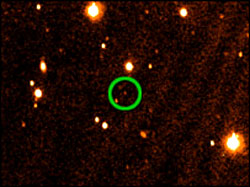|

by Dr David Whitehouse
BBC News Online science editor
Last Updated: Monday,
15 March, 2004 01:12 GMT |
 |
|

Sedna is currently about 13 billion km from Earth |
Astronomers have detected what could be the Solar System's 10th planet.
It was first seen by astronomers using California's Mount Palomar
Observatory, and has been given the name "Sedna" after the Inuit goddess of
the ocean.
(click right image to watch video)
Observations show it measures about 1,180-2,360km (730-1,470 miles) across,
making it similar in size to Pluto.
There is likely to be some debate about whether it qualifies as a true
planet, but some scientists are already saying it re-defines our Solar
System.
Further than Pluto
Sedna, or 2003 VB16, as it was originally designated, is the most distant
object yet found orbiting our Sun. It is three times further away than Pluto
(average distance to the Sun is 5.9 billion km or 3.6 billion miles).
It was discovered using the Mt Palomar facility in November by astronomers
from the California Institute of Technology, Yale Observatory and the Gemini
Observatory.
Follow-up studies by the Tanagra Observatory have measured the thermal
radiation coming from Sedna to determine how hot it is, and therefore
provide some estimate of its size.
|

Click image to see Sedna's size and distance from the sun
|
His estimate is
uncertain but the object is likely to be between half the diameter
of Pluto (2,360km or 1,470 miles) and Pluto's
size; though some astronomers think it could be larger than the
ninth planet itself.
From the observations made so far, astronomers have determined Sedna's orbit
to be a very large one.
It is currently 90 times the Earth-Sun distance away (149 million km or 93
million miles), but its orbit can take it 10 times further away still.
Small worlds
Although Sedna could be a so-called Kuiper Belt object, its discoverers are
unsure if it is as they consider it to be unlike any other object yet found.
The KB contains hundreds of known objects and astronomers believe there are
many more awaiting discovery. Most are small worlds of rock and ice but some
could rival Pluto in size.
In recent years, astronomical work has thrown up several big objects. Quaoar,
found in 2002, is about 1,200km (745 miles) across. Ixion, discovered in
2001, is 1,065 km (660 miles) wide. Varuna, detected in 2000, has a diameter
of approximately 900 km (560 miles).
And only in February this year, scientists picked up the object 2004 DW,
which is though to be 1,800km (1,120 miles) across.
The importance of Sedna is that it could be the first such world discovered
in its normal orbit. Other similar though smaller worlds, like Quaoar and
Varuna, originated in the KB but have since been perturbed into different
orbits.
More follow-up observations are being carried out by the Hubble Space
Telescope and the Gemini Observatory.
Is it a planet?
The new discovery will reignite the debate about what constitutes a planet.
One group of astronomers believe that Pluto is not a true planet but merely
one of the largest of a vast number of minor objects in the outer Solar
System.
The alternative standpoint is that Pluto is a planet and those who believe
that will have to classify Sedna as the 10th planet.
The name Sedna has been provided by its discoverers.
However, if its planetary status is confirmed, it may be that astronomy's
governing body, the International Astronomical Union, will want to
reconsider this, to make it more consistent with the mythological names of
other planets.
|